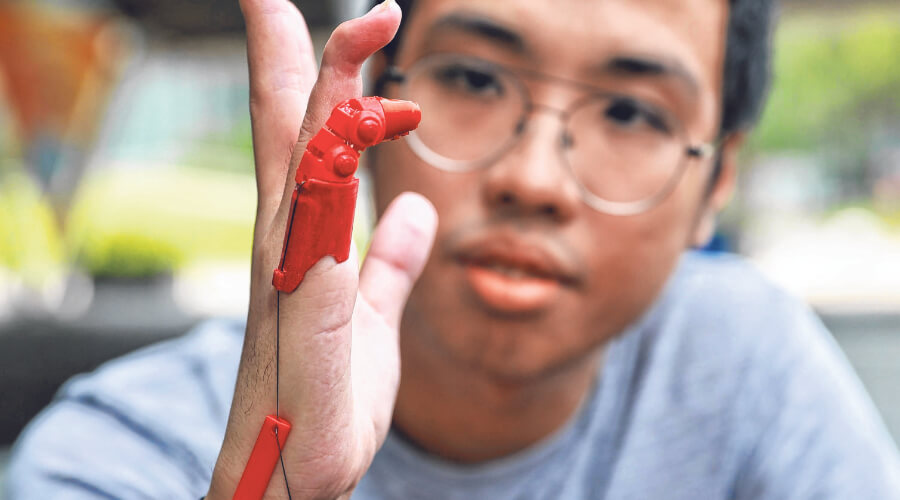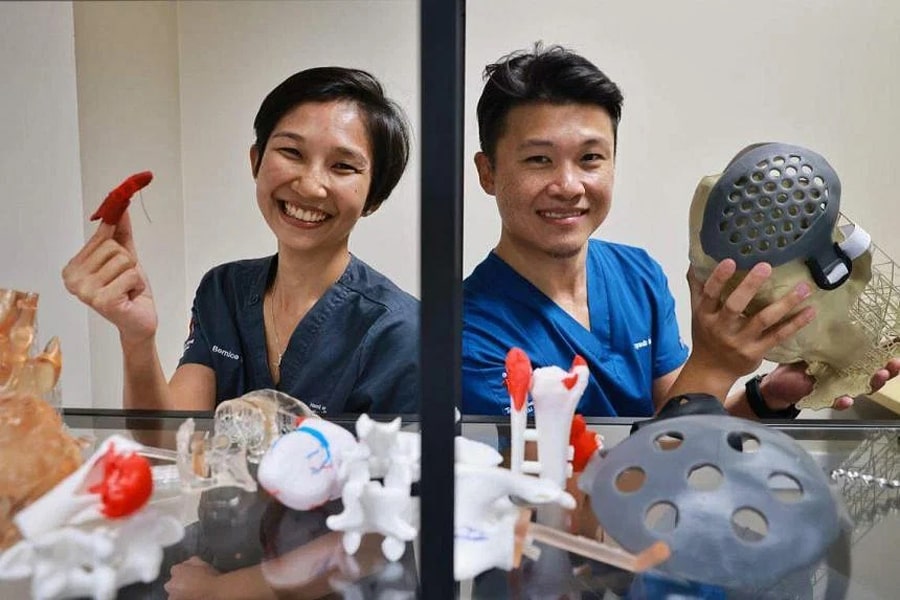 Polytechnic student Russel Ko, who had lost his right pinky in an accident, wearing a 3D-printed functional finger prosthesis from Tan Tock Seng Hospital on Friday. ST PHOTOS: KEVIN LIM
Polytechnic student Russel Ko, who had lost his right pinky in an accident, wearing a 3D-printed functional finger prosthesis from Tan Tock Seng Hospital on Friday. ST PHOTOS: KEVIN LIM
The Sunday Times (16 April 2023)
Two inventions tapping 3D printing are helping Tan Tock Seng Hospital (TTSH) patients, such as those who have lost their fingers or part of their skulls, in their recovery journey.
One beneficiary is final-year polytechnic student Russel Ko, who was riding pillion on his friend’s motorbike in October 2022 when it hit a car.
Mr Ko’s right hand was caught in the motorbike’s wheel, and his ring finger and pinky were severed.
“At first, I did not know my fingers were missing, and I still stood up. It was only when I felt my hand was numb and I looked down (that I realised my fingers were missing),” said Mr Ko, 21.
“The shock really hit me and I just fell, laid down on the road and cried for help.”
cried for help.” His friend retrieved the fingers, but TTSH doctors were able to save and reattach only his ring finger.
Fortunately, Mr Ko was eligible for a TTSH pilot study for 3D-printed functional finger prostheses. The project was part of a media showcase on Thursday of the capabilities of the hospital’s Medical 3D Printing Centre.
Dr Bernice Heng, associate consultant at TTSH’s
hand and reconstructive microsurgery department, said the hospital sees about 20 to 30 cases of amputated fingers a year, a result of industrial and road traffic accidents.
According to media reports, 46 workers lost their hands or fingers in amputation accidents in 2020, mainly due to the unsafe use of machinery.
Dr Heng said that typically, patients would be offered a cosmetic finger prosthesis, which looks real but is not functional. But the 3D-printed option with movable joints, made in the Medical 3D Printing Centre, would be able to return close to normal function to the patients.
It costs a few hundred dollars, compared with a few thousand dollars for a cosmetic prosthesis.
Previously, Dr Heng was aware only of cosmetic fingers or myoelectric prostheses that use muscle activity to power movement. Patients were not keen to wear these larger-sized prostheses.
“But this 3D-printed finger prosthesis is lightweight and functional, and patients take to them better,” she added.
Mr Ko is now waiting for his prosthesis as the centre is refining it for length and comfort.
“I am definitely looking forward to receiving my pinky. There are some difficulties in daily activities like opening a bottle... or carrying heavy stuff. As an engineering student, I also have to use some tools to do work. Without the pinky, my hand is less stable,” he said.
 Tan Tock Seng Hospital's Dr Bernice Heng (left) with a 3D-printed finger prosthesis and Dr Michael Yam holding a cranial cap on Friday.
Tan Tock Seng Hospital's Dr Bernice Heng (left) with a 3D-printed finger prosthesis and Dr Michael Yam holding a cranial cap on Friday.
Another 3D printing project is benefiting patients who have had craniectomy, a life-saving surgical procedure to remove a portion of the skull to help relieve pressure on the brain after a massive stroke or brain injury.
After that surgery, some patients have had to wait up to a year to undergo a second operation to restore the skull. In the meantime, they would typically have to wear helmets to protect their heads, but these are hot and uncomfortable, especially in Singapore’s climate.
Associate Professor Karen Chua Sui Geok, senior consultant at TTSH’s Rehabilitation Centre, said protective helmets that are reinforced internally can weigh close to 400g.
“So, 400g is like two pieces of steak. So, would I put two pieces of steak on my head and walk around the whole day to protect my cranium (part of the skull enclosing the brain)?
“So, clearly, while we discharge our patients... with helmets, they don’t wear them. Some will come to the clinic with no protection except a cap, scarf or beanie,” she noted.
There have been cases in Singapore where the patients died after falling and hitting their heads.
Between March 2019 and March 2021, with a $20,000 innovation grant, Prof Chua’s team worked with an external vendor to produce 3D-printed cranial caps for such patients.
Using CT scans and photographs, as well as taking into consideration factors such as whether the person wore glasses, each cranial cap was customised to fit the patient.
“We did a small trial of about 10 patients, and it was very well received. Eighty-five per cent of patients said they liked it. It was very lightweight – it weighed about 60g, and the heaviest we had was 100g. There was also no damage to the skin,” said Prof Chua.
The team is now working with the Medical 3D Printing Centre to scale up the programme. It has refined the cranial cap’s design such that stroke patients who typically experience weakness on one side of their body can wear it with one hand.
The hospital has also put in an intellectual property application for the cap, and hopes to expand the offering through referrals and to other hospitals in the future.
The pilot project of almost four months at Tan Tock Seng Hospital offers hope for people in need of
custom-designed prostheses.
Read more